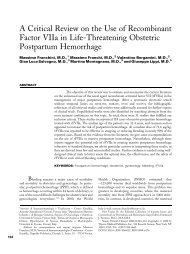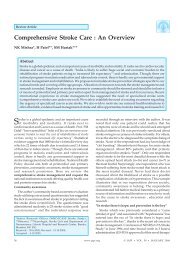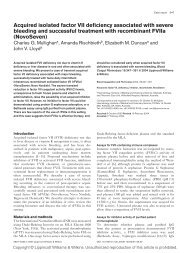Pathophysiology and management of dengue hemorrhagic fever
Pathophysiology and management of dengue hemorrhagic fever
Pathophysiology and management of dengue hemorrhagic fever
Create successful ePaper yourself
Turn your PDF publications into a flip-book with our unique Google optimized e-Paper software.
10 CHUANSUMRIT & TANGNARARATCHAKIT | MANAGEMENT OF DENGUE HEMORRHAGIC FEVER<br />
This rFVIIa therapy is suggested whenever the unresponsiveness<br />
<strong>of</strong> massive bleeding to blood component<br />
therapy is recognized. Massive blood loss signifies that<br />
blood loss is greater than 1.5 mL/kg/minute within 20<br />
minutes 51 or 150 mL/minute. 52 Also, massive blood loss<br />
is signified by the replacement <strong>of</strong> 50% blood volume in<br />
less than 3 hours. 53 Unresponsiveness to conventional<br />
blood component therapy signifies that the bleeding<br />
does not slow down even though the patient has already<br />
received 10 mL/kg <strong>of</strong> FFP, 0.2 unit/kg <strong>of</strong> platelet concentrate<br />
(maximum 8–10 units) <strong>and</strong> 0.2 unit/kg <strong>of</strong> cryoprecipitate.<br />
The suggested dose <strong>of</strong> rFVIIa is 100 µg/kg<br />
at 15- to 30-minute intervals until the bleeding is<br />
significantly reduced, followed by 100 µg/kg at 2- to 4hour<br />
intervals. One to two doses are usually used at 15to<br />
30-minute intervals <strong>and</strong> two to four doses are usually<br />
used at 2- to 4-hour intervals. After the bleeding is<br />
completely stopped, the final dose may be given to<br />
achieve hemostasis. From 2000 to 2004, a total <strong>of</strong> 43<br />
REFERENCES<br />
1 Rush B. An account <strong>of</strong> the bilous remitting<br />
<strong>fever</strong>, as it appeared in Philadelphia<br />
in the summer <strong>and</strong> autumn <strong>of</strong> the year<br />
1780. In: Rush B (ed.). Medical Inquiries<br />
<strong>and</strong> Observations. Pritchard <strong>and</strong> Hall:<br />
Philadelphia, PA, 1989, p. 104.<br />
2 Hare FE. The 1897 epidemic <strong>of</strong> <strong>dengue</strong> in<br />
North Queensl<strong>and</strong>. Australas Med Gaz<br />
1898; 17: 98.<br />
3 Rigau-Perez JG, Clark GG, Gubler DJ,<br />
et al. Dengue <strong>and</strong> <strong>dengue</strong> <strong>hemorrhagic</strong><br />
<strong>fever</strong>. Lancet 1998; 352: 971–7.<br />
4 Rico-Hesse R. Molecular evolution <strong>and</strong><br />
distribution <strong>of</strong> <strong>dengue</strong> viruses types 1 <strong>and</strong><br />
2 in nature. Virology 1990; 174–93.<br />
5 Rico-Hesse R, Harrison LM, Salas RA,<br />
et al. Origins <strong>of</strong> <strong>dengue</strong> type 2 viruses<br />
associated with increased pathogenicity in<br />
the Americas. Virology 1997; 230: 244–51.<br />
6 Rico-Hesse R, Harrison LM, Nisalak A,<br />
et al. Molecular evolution <strong>of</strong> <strong>dengue</strong> type<br />
2 virus in Thail<strong>and</strong>. Am J Trop Med Hyg<br />
1998; 58: 96–101.<br />
7World Health Organization. Clinical diagnosis.<br />
In: Dengue Haemorrhagic Fever:<br />
Diagnosis, Treatment, Prevention <strong>and</strong><br />
Control, 2nd edn. WHO: Geneva, 1997, pp.<br />
12–23.<br />
8 Phuong CX, Nhan NT, Kneen R, et al.<br />
patients with massive uncontrolled bleeding, mainly in<br />
<strong>dengue</strong> shock syndrome in Thail<strong>and</strong>, were treated with<br />
rFVIIa. The effective response was 62.8% (27/43) <strong>and</strong><br />
the case–fatality rate was 25.6% (11/43).<br />
CONCLUSIONS<br />
Clinical diagnosis <strong>and</strong> assessment <strong>of</strong><br />
severity <strong>of</strong> confirmed <strong>dengue</strong> infections in<br />
Vietnamese children: is the World Health<br />
Organization classification system helpful?<br />
Am J Trop Med Hyg 2004; 70: 172–<br />
9.<br />
9 Malasit P. Complement <strong>and</strong> <strong>dengue</strong> <strong>hemorrhagic</strong><br />
<strong>fever</strong>/<strong>dengue</strong> shock syndrome.<br />
Southeast Asian J Trop Med Public Health<br />
1987; 18: 316–20.<br />
10 Bokisch VA, Top FH Jr, Russell PK, Dixon<br />
FJ, Muller-Eberhard HJ. The potential<br />
pathogenic role <strong>of</strong> complement in <strong>dengue</strong><br />
<strong>hemorrhagic</strong> shock syndrome. N Engl J<br />
Med 1973; 289: 996–1000.<br />
11 Suvatte V, Pongpipat D, Tuchinda S, et al.<br />
Studies on serum complement C3 <strong>and</strong><br />
fibrinogen degradation product in Thai<br />
<strong>hemorrhagic</strong> <strong>fever</strong>. J Med Assoc Thai<br />
1973; 56: 24–32.<br />
12 Suvatte V. Immunological aspects <strong>of</strong><br />
<strong>dengue</strong> <strong>hemorrhagic</strong> <strong>fever</strong>: studies in<br />
Thail<strong>and</strong>. Southeast Asian J Trop Med<br />
Public Health 1987; 18: 312–15.<br />
13 Kurane T, Ennis FA. Immunopathogenesis<br />
<strong>of</strong> <strong>dengue</strong> virus infection. In: Gubler DJ,<br />
Kuno G (eds). Dengue <strong>and</strong> Dengue Hemorrhagic<br />
Fever. CAB International:<br />
Wallingford, 1997, pp. 273–90.<br />
14 Kurane I, Innis BL, Nimmannitya S, et al.<br />
Human immune responses to <strong>dengue</strong><br />
The prominent features <strong>of</strong> DHF are shock <strong>and</strong> hemorrhage.<br />
Shock is caused by rapid plasma leakage resulting<br />
from increased vascular permeability. Bleeding is<br />
caused by vasculopathy, thrombocytopenia, platelet<br />
dysfunction <strong>and</strong> coagulopathy. There is no specific<br />
treatment for DHF; intensive supportive care is the most<br />
important aspect <strong>of</strong> <strong>management</strong>. Early recognition <strong>of</strong><br />
the disease <strong>and</strong> circulatory disturbance is essential <strong>and</strong><br />
appropriate intravenous fluid replacement can modify<br />
the severity <strong>of</strong> the disease. rFVIIa is very effective in<br />
controlling severe hemorrhage in this disease.<br />
viruses. Southeast Asian J Trop Med Public<br />
Health 1990; 21: 658–62.<br />
15 Halstead SB. The pathogenesis <strong>of</strong> <strong>dengue</strong>:<br />
challenges to molecular biology. Science<br />
1988; 239: 476–81.<br />
16 Mongkolsapaya J, Dejnirattisai W, Xu XN,<br />
et al. Original antigenic sin <strong>and</strong> apoptosis<br />
in the pathogenesis <strong>of</strong> <strong>dengue</strong> <strong>hemorrhagic</strong><br />
<strong>fever</strong>. Nat Med 2003; 9: 921–7.<br />
17 Halstead SB, Rojanasuphot S, Sangkawibha<br />
N. Original antigenic sin in <strong>dengue</strong>. Am J<br />
Trop Med Hyg 1983; 32: 154–6.<br />
18 Navarro-Sanchez E, Despres P, Cedillo-<br />
Barron L. Innate immune responses to<br />
<strong>dengue</strong> virus. Arch Med Res 2005; 36:<br />
425–35.<br />
19 Sakuntabhai A, Turbpaiboon C,<br />
Casademont I, et al. A variant in the<br />
CD209 promoter is associated with severity<br />
<strong>of</strong> <strong>dengue</strong> disease. Nat Genet 2005; 37:<br />
507–13.<br />
20 Martin MP, Lederman MM, Hutcheson HB,<br />
et al. Association <strong>of</strong> DC-SIGN promoter<br />
polymorphism with increased risk for<br />
parenteral, but not mucosal, acquisition <strong>of</strong><br />
human immunodeficiency virus type 1<br />
infection. J Virol 2004; 78: 14054–6.<br />
21 Suwanik R, Tuchinda P, Tuchinda S, et al.<br />
Plasma volume <strong>and</strong> other fluid space<br />
studies in Thai <strong>hemorrhagic</strong> <strong>fever</strong>. J Med<br />
Assoc Thai 1967; 50: 48–66.<br />
© 2006 The Authors<br />
Journal Compilation © 2006 LMS Group • Transfusion Alternatives in Transfusion Medicine 8 (Suppl. 1), 3–11





